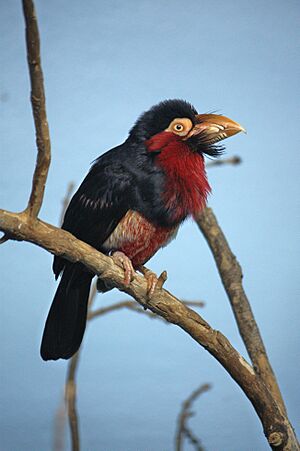Bearded barbet facts for kids
Quick facts for kids Bearded barbet |
|
|---|---|
 |
|
| Bearded barbet at Denver Zoo, Colorado | |
| Conservation status | |
| Scientific classification | |
| Genus: |
Pogonornis
|
| Species: |
dubius
|
| Synonyms | |
|
Lybius dubius |
|
The bearded barbet (Pogonornis dubius) is a colorful bird found in Africa. It belongs to a group of birds called barbets. These birds live in warm, tropical places around the world. Barbets get their name from the special bristles that look like a beard around their strong beaks.
Contents
About the Bearded Barbet's Name
The bearded barbet was first officially described in 1788. A German scientist named Johann Friedrich Gmelin gave it the scientific name Bucco dubius. The word "dubius" comes from Latin and means "doubtful" or "dubious." This was because early naturalists weren't sure which group of birds it belonged to.
Today, the bearded barbet is placed in the genus Lybius. This genus includes 12 other types of barbets. There are no different types or subspecies of the bearded barbet recognized.
What Does a Bearded Barbet Look Like?
This is a large and easy-to-spot bird. It grows to about 26 centimetres (10 in) long. It has a plump body, a short neck, and a big head. Its tail is also quite short.
Adult bearded barbets have a black top of the head, back, and tail. They also have a black band across their chest. Their throat and belly are bright red. They have a yellow patch around their eyes. The lower back area, called the rump, is white.
Their beak is very large, thick, and yellow. The "beard" of bristles at the base of its beak gives the bird its name. Male and female bearded barbets look very similar. When they call, they make a growling sound, like "scrawk."
Where Do Bearded Barbets Live?
The bearded barbet is a common bird in tropical west Africa. It prefers to live in trees in gardens and wooded areas. You can often find them where there are many fig trees. They will even visit gardens to find fruit.
How Do Bearded Barbets Behave?
Bearded barbets are social birds. They often live in small groups of 4 or 5 birds. These groups, or even just pairs, will sleep together inside a hole in a tree.
When it's time to nest, they also use a tree hole. The female barbet lays two white eggs. While adult barbets mostly eat fruit, they feed their young insects.
Gallery





